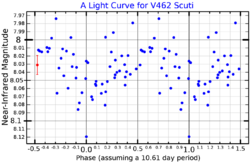Astronomy:WR 120
 A near-infrared (2.033 micron) light curve for V462 Scuti, adapted from Chené and St-Louis (2007).[1] The left-most point shows the 3 sigma error bar. | |
| Observation data Equinox J2000.0]] (ICRS) | |
|---|---|
| Constellation | Scutum |
| Right ascension | 18h 41m 00.86698s[2] |
| Declination | −4° 26′ 14.47345″[2] |
| Apparent magnitude (V) | 11.93[3] |
| Characteristics | |
| Evolutionary stage | Wolf-Rayet |
| Spectral type | WN7w[4] + WN3/4[5] |
| U−B color index | 0.13[6] |
| B−V color index | 1.04[6] |
| Astrometry | |
| Proper motion (μ) | RA: −0.489[7] mas/yr Dec.: −2.524[7] mas/yr |
| Parallax (π) | 0.3246 ± 0.0541[7] mas |
| Distance | approx. 10,000 ly (approx. 3,100 pc) |
| Absolute magnitude (MV) | −3.81[4] |
| Details | |
| Mass | 7[4] M☉ |
| Radius | 3.78[4] R☉ |
| Luminosity | 83,200[4] L☉ |
| Temperature | 50,100[4] K |
| Other designations | |
| Database references | |
| SIMBAD | data |
WR 120 is a binary containing two Wolf-Rayet stars in the constellation of Scutum, around 10,000 light years away. The primary is a hydrogen-free weak-lined WN7 star, the secondary is a hydrogen-free WN3 or 4 star, and the system is a possible member of the cluster Dolidze 33.[8] From our point of view, WR 120 is reddened by 4.82 magnitudes, and it has the variable designation of V462 Scuti.[9]
Properties
Analysis of the primary's spectrum with PoWR shows that it has a temperature of around 50,000 Kelvins, and is losing mass at a rate of 10−4.9 M☉/year, or 1 solar mass every 80,000 years, which is being carried away from the surface at a speed of 1,225 kilometres per second.[4] Taking its close distance into account, WR 120 A's luminosity turns out to be a mere 83,200 L☉, which would make it one of the dimmest WN stars known, and one of the only WN stars with a luminosity below 100,000 L☉. Using the Stefan-Boltzmann Law, a radius of 3.78 R☉ is derived, and a "transformed" radius at an optical depth of 2/3, more comparable to other types of stars, is at about 6 R☉. Using the WR Luminosity-Mass ratio, WR 120 may have a mass of just 7 M☉, one of the lowest masses of any WR star. WR 120 A’s visual luminosity is 2,858 L☉, which is also on the lower end of WR visual luminosities.[4]
WR 120 is thought to be a member of Dolidze 33, an open cluster nearly 3,000 pc away.[8]
Binarity
In 2021, WR 120 was revealed to be a binary star. Previously, it was thought to be a single WR star, but it is in fact a rare double Wolf-Rayet star. The companion (a WN3/4 WR star) is located approximately 1700 AU from the primary WN7 WR, and is about 2.1 magnitudes fainter than WR 120.
References
- ↑ Chené, André-Nicolas (2007). "The First Determination of the Rotation Rates of Wolf-Rayet Stars". Massive Stars as Cosmic Engines, Proceedings IAU Symposium 250: 139–144. doi:10.1017/S1743921308020425.
- ↑ 2.0 2.1 Gaia Collaboration (2018-04-01). "VizieR Online Data Catalog: Gaia DR2 (Gaia Collaboration, 2018)". VizieR Online Data Catalog 1345. Bibcode: 2018yCat.1345....0G.
- ↑ Zacharias, N. (2012). "The fourth US Naval Observatory CCD Astrograph Catalog (UCAC4)". VizieR On-line Data Catalog. Bibcode: 2012yCat.1322....0Z.
- ↑ 4.0 4.1 4.2 4.3 4.4 4.5 4.6 4.7 Hamann, W.-R.; Gräfener, G.; Liermann, A.; Hainich, R.; Sander, A. A. C.; Shenar, T.; Ramachandran, V.; Todt, H. et al. (2019-05-01). "The Galactic WN stars revisited. Impact of Gaia distances on fundamental stellar parameters". Astronomy and Astrophysics 625: A57. doi:10.1051/0004-6361/201834850. ISSN 0004-6361. Bibcode: 2019A&A...625A..57H.
- ↑ Shara, Michael M.; Howell, Steve B.; Furlan, Elise; Gnilka, Crystal L.; Moffat, Anthony F. J.; Scott, Nicholas J.; Zurek, David (2022-01-01). "A speckle-imaging search for close and very faint companions to the nearest and brightest Wolf-Rayet stars". Monthly Notices of the Royal Astronomical Society 509 (2): 2897–2907. doi:10.1093/mnras/stab2666. ISSN 0035-8711. Bibcode: 2022MNRAS.509.2897S.
- ↑ 6.0 6.1 Ducati, J. R. (2002). "VizieR Online Data Catalog: Catalogue of Stellar Photometry in Johnson's 11-color system.". VizieR Online Data Catalog 2237. Bibcode: 2002yCat.2237....0D.
- ↑ 7.0 7.1 7.2 Brown, A. G. A. (2021). "Gaia Early Data Release 3: Summary of the contents and survey properties". Astronomy & Astrophysics 649: A1. doi:10.1051/0004-6361/202039657. Bibcode: 2021A&A...649A...1G. Gaia EDR3 record for this source at VizieR.
- ↑ 8.0 8.1 Rate, Gemma; Crowther, Paul A.; Parker, Richard J. (2020-06-01). "Unlocking Galactic Wolf-Rayet stars with Gaia DR2 - II. Cluster and association membership". Monthly Notices of the Royal Astronomical Society 495 (1): 1209–1226. doi:10.1093/mnras/staa1290. ISSN 0035-8711. Bibcode: 2020MNRAS.495.1209R.
- ↑ Crowther, Paul A.; Rate, Gemma (2020). "Unlocking Galactic Wolf–Rayet stars with Gaia DR2 – I. Distances and absolute magnitudes". Monthly Notices of the Royal Astronomical Society 493 (1): 1512–1529. doi:10.1093/mnras/stz3614. Bibcode: 2020MNRAS.493.1512R.
 |

